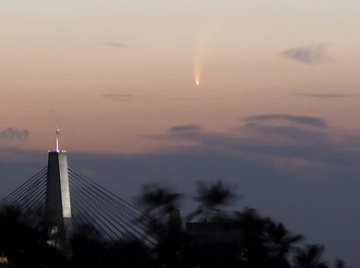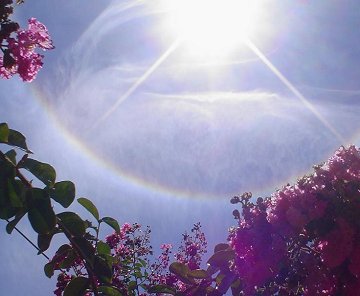 Did you sleep through the auroras of Dec. 14th? Next time get a wake-up call: Spaceweather PHONE.
Did you sleep through the auroras of Dec. 14th? Next time get a wake-up call: Spaceweather PHONE.
GREAT COMET: "Here in Argentina, Comet McNaught is a real hit. It's a wonderful sight after sunset," reports Mariano Ribas of Buenos Aires. "The comet's magnitude is around -3, and its bright and curved tail is easy to see with the naked eye: image."
The comet is widely visible from all parts of the Southern Hemisphere. This Jan. 16th picture comes from Grahame Kelaher of Sydney, Australia:

Photo details: Canon 20D, 300mm lens, f/5.6, ISO 200, ~1 sec exposure
Rewind to Jan. 13th: Comet McNaught flew past the sun even closer than Mercury. Fierce heat puffed up the comet, making it visible in broad daylight. Anyone who saw the comet in blue sky knew it was going to be good when it emerged from the glare, and now it is living up to the hype.
Comet McNaught is no longer visible from the northern hemisphere, but it should remain a spectacular fixture in sunset skies of the south for weeks to come. Stay tuned!
Comet McNaught Photo Gallery
[finder chart] [ephemeris] [orbit] [comet binoculars]
GREAT HALO: In Porto Alegre, Brazil, yesterday a brilliant ring of light surrounded the sun. Chief meteorologist Eugenio Hackbart of the MetSul Weather Center snapped this picture:

"It scared some people," reports Hackbart. "We received many e-mails and phone calls to our weather center asking, was there a connection to the comet?"
In short, no. The ring of light is an ice halo caused by tiny crystals of frozen water floating in clouds about 10 km above the ground. Comet McNaught, some 120 million km away, was totally irrelevant. And that's good news, because it means we can see ice halos anytime--no comet required.
more images: from Rodrigo Asssman at a church in Santa Cruz do Sul, Brazil; from John Stetson of Falmouth, Maine;

